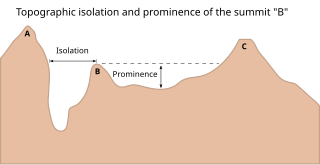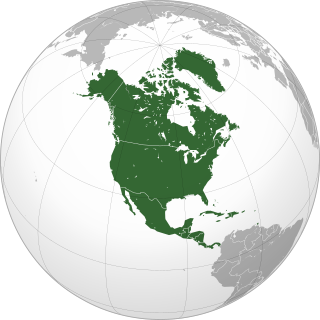
Denali is the highest mountain peak in North America, with a summit elevation of 20,310 feet (6,190 m) above sea level. It is the tallest mountain in the world from base-to-peak on land, measuring 18,000 ft (5,500 m), with a topographic prominence of 20,194 feet (6,155 m) and a topographic isolation of 4,621.1 miles (7,436.9 km), Denali is the third most prominent and third-most isolated peak on Earth, after Mount Everest and Aconcagua. Located in the Alaska Range in the interior of the U.S. state of Alaska, Denali is the centerpiece of Denali National Park and Preserve.

In the mountaineering parlance of the Western United States, a fourteener is a mountain peak with an elevation of at least 14,000 ft (4267 m). The 96 fourteeners in the United States are all west of the Mississippi River. Colorado has the most (53) of any single state; Alaska is second with 29. Many peak baggers try to climb all fourteeners in the contiguous United States, one particular state, or another region.

In topography, prominence or relative height measures the height of a mountain or hill's summit relative to the lowest contour line encircling it but containing no higher summit within it. It is a measure of the independence of a summit. The key col ("saddle") around the peak is a unique point on this contour line and the parent peak is some higher mountain, selected according to various criteria.

This is a list of the extreme points of North America: the points that are highest and lowest, and farther north, south, east or west than any other location on the continent. Some of these points are debatable, given the varying definitions of North America.

Frederick Albert Cook was an American explorer, physician and ethnographer, who is most known for allegedly being the first to reach the North Pole on April 21, 1908. A competing claim was made a year later by Robert Peary, though both men's accounts have since been fiercely disputed; in December 1909, after reviewing Cook's limited records, a commission of the University of Copenhagen ruled his claim unproven. Nonetheless, in 1911, Cook published a memoir of the expedition in which he maintained the veracity of his assertions. In addition, he also claimed to have been the first person to reach the summit of Denali, the highest mountain in North America, a claim which has since been similarly discredited. Though he may not have achieved either Denali or the North Pole, his was the first and only expedition where a United States national discovered an Arctic island, Meighen Island.

Mount Hunter or Begguya is a mountain in Denali National Park in Alaska. It is approximately eight miles (13 km) south of Denali, the highest peak in North America. "Begguya" means child in the Dena'ina language. Mount Hunter is the third-highest major peak in the Alaska Range.

Ruth Glacier is a glacier in Denali National Park and Preserve in the U.S. state of Alaska. Its upper reaches are approximately 3 vertical miles below the summit of Denali. The glacier's "Great Gorge" is one mile wide, and drops almost 2,000 feet (610 m) over 10 miles (16 km), with crevasses along the surface. Above the surface on both sides are 4,900 feet (1,500 m) granite cliffs. From the top of the cliffs to the bottom of the glacier is a height exceeding that of the Grand Canyon. Ruth Glacier moves at a rate of 3 feet (0.91 m) per day and was measured to be 4,000 feet (1,200 m) thick in 1983.

Mount Russell is one of the major peaks of the central Alaska Range, approximately 35 mi (56 km) southwest of Denali. Though much lower than Denali or its neighbor Mount Foraker, Russell is a steep, dramatic peak and a significant mountaineering challenge in its own right. To give a sense of its size and steepness, note that its summit rises 6,560 ft (2,000 m) over the Chedotlothna Glacier to the northwest in only 1.8 mi (2.9 km), and almost 10,000 ft (3,000 m) above the lower Yentna Glacier to the south in only 8 mi (13 km).
Castle Rock is a mountain in Denali Borough in Alaska in the United States.

Graovo Rocks is the group of rocks off the north coast of Robert Island in the South Shetland Islands, Antarctica. They are situated east of Lientur Rocks and southwest of Liberty Rocks, and extend 1.75 km (1.09 mi) in north-south direction and 750 m (820 yd) in east-west direction.
Point 2210 is a 2,210-foot (670 m) peak in Cook County, Minnesota, United States, the fifth-highest-ranked peak in the state. It has three closed contours of between 2,200 and 2,219 feet, and survey has not determined which is taller. Two of these summits have less than 20 feet of prominence from each other, but a third has several hundred feet and is located more than two miles to the west. There is no summit trail.
Farquhar Peak is a summit in Cook County, Minnesota, in the United States. With an elevation of 1,250 feet (380 m), Farquhar Peak is the 70th highest summit in the state of Minnesota. Farquhar Peak was named for a government surveyor.

Mount Johnson is an 8,400+ ft mountain summit located in the Alaska Range, in Denali National Park and Preserve, in Alaska, United States. It is situated on the west side of the Ruth Gorge, 15 miles (24 km) southeast of Denali and six miles (9.7 km) south-southwest of The Moose's Tooth. The nearest higher neighbor is Mount Wake, 0.69 miles (1.11 km) to the northwest.

Mount Barrille is a 7,650 ft (2,330 m) mountain summit located in the Alaska Range, in Denali National Park and Preserve, in the U.S. state of Alaska. It is situated 2,650 feet above the Ruth Glacier at the gateway to the Don Sheldon Amphitheater, or The Great Gorge, depending on direction of travel. Barrille is set 11.43 mi (18 km) southeast of Denali, 3.37 mi (5 km) west of The Mooses Tooth, 3.68 mi (6 km) east of The Rooster Comb, and 1.42 mi (2 km) north of Mount Dickey which is the nearest higher peak. The mountain was named by famed explorer Dr. Frederick Cook for Edward Barrill (1861–1946), a horse packer from Darby, Montana, who was his sole companion during his 1906 claim to be the first to climb Denali. The claim was later disproved, and in 1909 Barrill signed an affidavit stating that they had not reached the summit. Cook referred to his companion as Barrille in his accounts of the expedition, and Barrille remains as the official spelling used by the United States Geological Survey.












